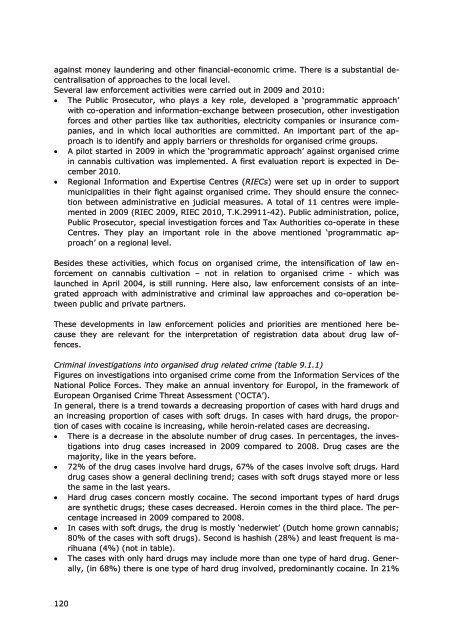The Netherlands Drug Situation 2010 - Trimbos-instituut
The Netherlands Drug Situation 2010 - Trimbos-instituut
The Netherlands Drug Situation 2010 - Trimbos-instituut
You also want an ePaper? Increase the reach of your titles
YUMPU automatically turns print PDFs into web optimized ePapers that Google loves.
against money laundering and other financial-economic crime. <strong>The</strong>re is a substantial decentralisationof approaches to the local level.Several law enforcement activities were carried out in 2009 and <strong>2010</strong>: <strong>The</strong> Public Prosecutor, who plays a key role, developed a ‘programmatic approach’with co-operation and information-exchange between prosecution, other investigationforces and other parties like tax authorities, electricity companies or insurance companies,and in which local authorities are committed. An important part of the approachis to identify and apply barriers or thresholds for organised crime groups. A pilot started in 2009 in which the ‘programmatic approach’ against organised crimein cannabis cultivation was implemented. A first evaluation report is expected in December<strong>2010</strong>. Regional Information and Expertise Centres (RIECs) were set up in order to supportmunicipalities in their fight against organised crime. <strong>The</strong>y should ensure the connectionbetween administrative en judicial measures. A total of 11 centres were implementedin 2009 (RIEC 2009, RIEC <strong>2010</strong>, T.K.29911-42). Public administration, police,Public Prosecutor, special investigation forces and Tax Authorities co-operate in theseCentres. <strong>The</strong>y play an important role in the above mentioned ‘programmatic approach’on a regional level.Besides these activities, which focus on organised crime, the intensification of law enforcementon cannabis cultivation – not in relation to organised crime - which waslaunched in April 2004, is still running. Here also, law enforcement consists of an integratedapproach with administrative and criminal law approaches and co-operation betweenpublic and private partners.<strong>The</strong>se developments in law enforcement policies and priorities are mentioned here becausethey are relevant for the interpretation of registration data about drug law offences.Criminal investigations into organised drug related crime (table 9.1.1)Figures on investigations into organised crime come from the Information Services of theNational Police Forces. <strong>The</strong>y make an annual inventory for Europol, in the framework ofEuropean Organised Crime Threat Assessment (‘OCTA’).In general, there is a trend towards a decreasing proportion of cases with hard drugs andan increasing proportion of cases with soft drugs. In cases with hard drugs, the proportionof cases with cocaine is increasing, while heroin-related cases are decreasing. <strong>The</strong>re is a decrease in the absolute number of drug cases. In percentages, the investigationsinto drug cases increased in 2009 compared to 2008. <strong>Drug</strong> cases are themajority, like in the years before. 72% of the drug cases involve hard drugs, 67% of the cases involve soft drugs. Harddrug cases show a general declining trend; cases with soft drugs stayed more or lessthe same in the last years. Hard drug cases concern mostly cocaine. <strong>The</strong> second important types of hard drugsare synthetic drugs; these cases decreased. Heroin comes in the third place. <strong>The</strong> percentageincreased in 2009 compared to 2008. In cases with soft drugs, the drug is mostly ‘nederwiet’ (Dutch home grown cannabis;80% of the cases with soft drugs). Second is hashish (28%) and least frequent is marihuana(4%) (not in table). <strong>The</strong> cases with only hard drugs may include more than one type of hard drug. Generally,(in 68%) there is one type of hard drug involved, predominantly cocaine. In 21%120




